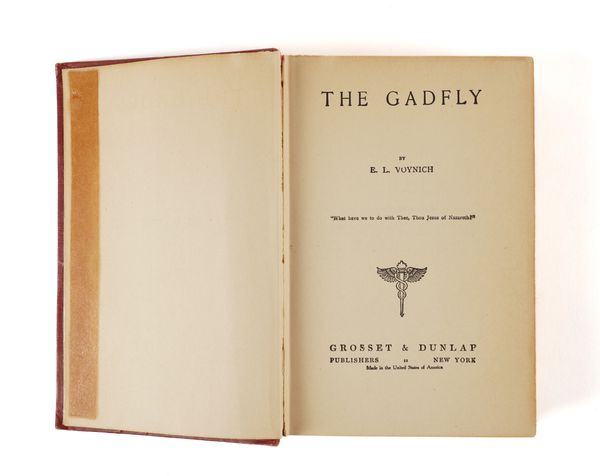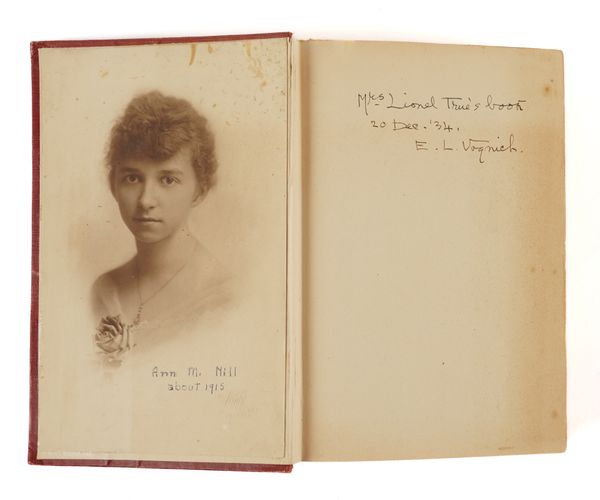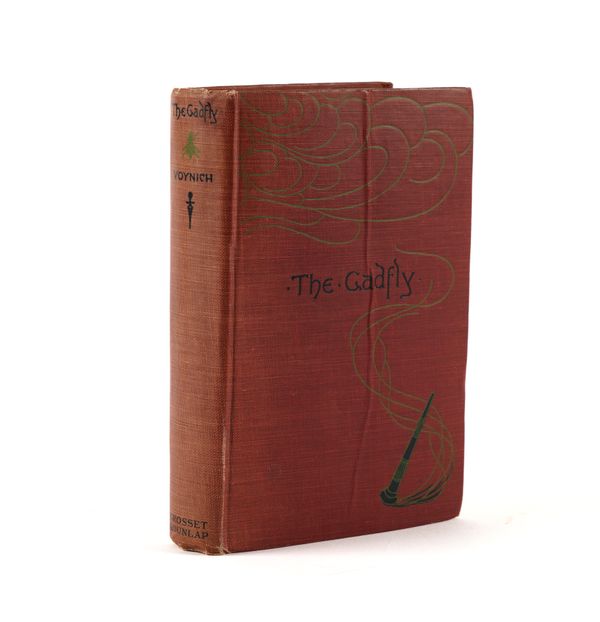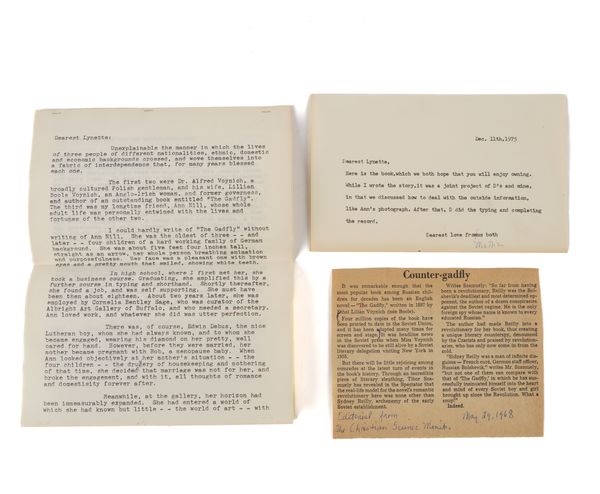Buyers Premium 25% + VAT | VAT is not applicable on bound books
VOYNICH, Ethel Lilian (1864-1960). The Gadfly, New York, "Grosset & Dunlap Publishers", [?]1897 [but later, see note below], 8vo, burgundy buckram. PRESENTATION COPY, the front free endpaper inscribed, "Mrs Lionel True's book, 20 Dec. '34. E. L. Voynich."
| Estimate: | £200 - £300 |
| Hammer price: | £100 |
VOYNICH, Ethel Lilian (1864-1960, née BOOLE). The Gadfly. New York: "Grosset & Dunlap Publishers" [on verso of title: Henry Holt & Co.], [?]1897 [but later, see note]. 8vo (187 x 125mm). Half title, printer's device on title, 373-pages, followed by 5-pages of publisher's advertisements (very lightly browned throughout). Original pictorial burgundy buckram to the same design as the Henry Holt binding of 1897 but with the lettering and a [?]torch on the upper cover blocked in black or very dark green rather than gilt, and the spine with a fly in pale green and lettering and printer's ornament in black (a single raised crease running from the top to the bottom of the upper cover). Provenance: photographed portrait laid down on the front pastedown, inscribed, "Ann M. Nill about 1915"; various typescripts and articles relating to the book loosely-inserted. PRESENTATION COPY, the front free endpaper inscribed, "Mrs Lionel True's book, 20 Dec. '34. E. L. Voynich." The publishing house Grosset & Dunlap was founded in New York in 1898, a year after the first publication of The Gadfly by Henry Holt & Co.. The publisher's advertisements at the end of the present copy include a page headed "Stirring Tales of The Great War" which lists Edith Wharton's "A Son at the Front" which was first published in 1923; hence the present copy must date from that year at the very earliest, and possibly even from as late as 1934, the year of the author's presentation inscription to Mrs. Lionel True [i.e. Ruth Hall]. Some letters in the text, usually at the edges of the text block, have been smudged in the printing process, giving this copy, if not the feel of a "piracy", the appearance that it may have been printed from type that was past its best: the book was known to have run into many editions. The provenance of this copy is complicated, and fascinating. The author, Ethel Lilian Boole, met Wilfrid Voynich (1865-1930, born Michal Habdank-Wojnicz), the Polish antiquarian, book collector and fellow revolutionary thinker, in 1890. By 1895 they were living together and she had adopted the Anglicised version of his surname, Voynich. They married in 1902. Ann [or sometimes Anne] Nill was Wilfrid Voynich's assistant for many years but, after his death, she stayed on to become Ethel's lifelong companion. Ruth Hall (i.e. the "Mrs Lionel True" of the presentation inscription) was a close friend of Ann's, and the author must have had her own reasons to present her with this unusual copy of "The Gadfly." The most extensive of the inserted typescripts is written by Ruth Hall to her daughter Lynette R. True (b.1919). It is undated and opens, "Dearest Lynette: Unexplained the manner in which the lives of three people of different nationalities, ethnic, domestic and economic backgrounds crossed, and wove themselves into a fabric of interdependence that, for many years blessed each one. The first two were Dr Alfred [sic] Voynich, a broadly cultured Polish gentleman, and his wife Lillian [sic] Boole Voynich, an Anglo-Irish woman, and former governess and author of an outstanding book entitled 'The Gadfly'. The third was my longtime friend, Ann Nill, whose whole adult life was personally entwined with the lives and fortunes of the other two ... Rather suddenly, in 1930, Mr. Voynich passed away and Ann lost a wonderful friend, and a wonderful experience. She was administrator of his estate. She lived with Mrs. Voynich, and cared for her tenderly during the remainder of her long life ..." Loosely-inserted is a clipping from "The Christian Science Monitor" for May 29, 1968, which states of the book: "It was remarkable enough that the most popular book among Russian children for decades has been an English novel - "The Gadfly," written in 1897 by Ethel Lilian Voynich (née Boole). Four million copies of the book have been printed to date [1968] in the Soviet Union and it has been adapted many times for screen and stage. It was headline news in the Soviet press when Miss Voynich was discovered to be still alive by a Soviet literary delegation visiting New York in 1955." Set during the Italian Risorgimento, the book primarily concerns itself with the culture of revolution and revolutionaries, hence its popularity in the Soviet Union, China and Iran. It was twice turned into an opera by Soviet composers, first by Mikhail Zhukov in 1928, and second by Antonio Spadavecchia in 1958. Soviet director Aleksandr Faintsimmer made a film of the book in 1955, for which Shostakovich wrote the music: it was arranged for concert performance as "The Gadfly Suite". Wilfrid Voynich is perhaps best known today for giving his name to the remarkable, and still undeciphered, "Voynich Manuscript" which he discovered among a group of manuscripts he purchased from the Villa Mondragone, Italy, in 1912, and owned until his death in 1930. It was then passed on to his wife Ethel, who, in 1960, bequeathed it to Ann Nill. In 1961, Nill sold it to the book dealer Hans P. Kraus, who, unable to find a buyer, donated it to Yale University's Beinecke Rare Book and Manuscript Library in 1969, where it remains to this day (Beinecke MS 408). See also Edward Brooke-Hitching's The Madman's Library (London, 2020, pp.70-77) for a full account, in the author's words, of "the most famous cryptic manuscript of the medieval period."



